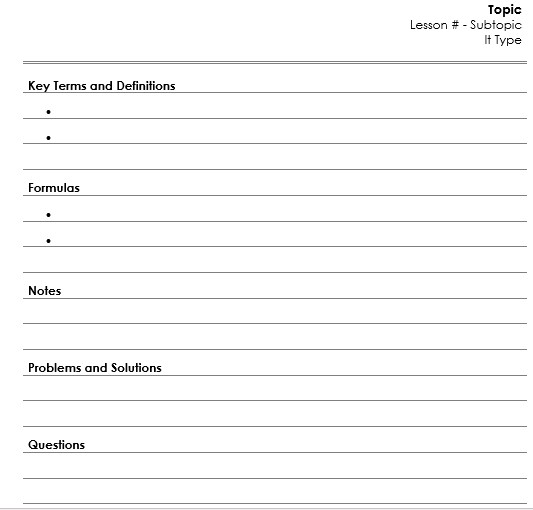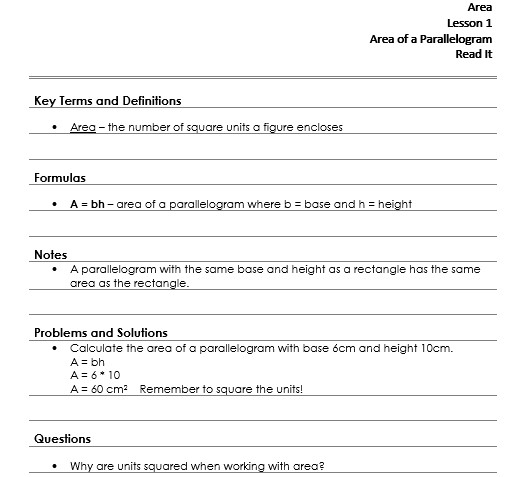4 min read
How To Help Your Online Student Get Organized in Math
By: Jodie Banyas and Melissa Tweed on Aug 21, 2019 10:30:21 AM

Whether your child is new to online learning or returning for a new year of digital coursework, it’s important to guide them along the way. Learning how to get organized is essential when it comes to online learning, particularly in math courses. In this blog, our online teachers offer their advice for helping your child create, compile, and organize notes for online mathematics courses.

Begin by reviewing the sample notebook template below. The sections that follow provide a quick how-to for setting up your child’s math notebook as well as note-taking tips and the ways in which they can benefit your online learner. Sections include headings, key terms and definitions, formulas, notes, problems and solutions, and questions.

Headings
In the top right corner of every page (whether in a digital notebook or hardcopy), encourage your student to note the lesson details. Depending on how their course is organized, these details may include the chapter name, lesson name, and associated page numbers. The template above offers heading suggestions for the Lincoln Empowered™ curriculum.
Notebook headings provide an organizational framework for studying and for locating particular concepts at a later time. Because math concepts build upon one another, having a quick reference to a foundational concept will help your child as they move through the course.
Key Terms and Definitions
On the left side of the page, below the heading, encourage your student to list the key terms and the definitions associated with the topic or lesson. When students physically write terms and definitions in their own words, they are better able to recall words and use them in context in the future.
By writing terms and definitions in their own words, your student is illustrating an understanding of the concept and is more likely to retain this information.
Formulas
Encourage your student to create a section dedicated specifically to the formulas within the lesson, if applicable. Be sure that they include a description explaining how to use the formula and what the variables represent. A consolidated formula section is a great reference tool, and it will help your student to link formulas with content.
Notes
In the Notes section, students should include any information that is new to them. Like taking notes in a traditional classroom, your student can notate new ideas, techniques, and concepts in this section.
Problems and Solutions
In the Problems and Solutions section, encourage your student to work through the problems in the lesson without referencing the solution (if one is given). While working through the problems, they can reference the notes they’ve already taken and use them to try to find the solution.
When your student is finished, have them check their work and write key comments about the solution or solution process in this section.
Practice problems are an important part of any mathematics course. Working through the problems and solutions provides practice for your student and helps to illustrate areas of confusion. When students demonstrate mastery of a concept while working through practice problems, it helps to boost their confidence.
Questions
It’s always a good idea for students to include a Questions section for each topic or lesson in their notes. Encourage your student to list any questions that they have about the content in this section. Then, have your student review the lesson to search for answers. If they find the answer, they should write it beside the question. If their questions remain unanswered, they should email their teacher or participate in the teacher’s office hours, if available.
Tip: When attending teacher office hours, your student should be prepared with as much detail as possible regarding their questions. For example, “I don’t understand area,” is difficult to address. However, a question such as the one that follows is specific and helps the teacher get to the root of where your student is struggling.
“Area is confusing to me. I’ve attempted problems 1-5 on page 224, but I don’t understand why units are squared when working with area.”
Use the completed notebook page below as a guide to help your student get their math notebook started! Remember, the notetaking process can be modified for any course. It can also be tailored to fit each student’s personal needs and learning styles.

 Jodie Banyas has taught high school business and math courses with Lincoln Learning Solutions for 10 years and has previous experience with IBM Finance. Jodie enjoys spending her free time with her family, traveling, reading, and walking her dog.
Jodie Banyas has taught high school business and math courses with Lincoln Learning Solutions for 10 years and has previous experience with IBM Finance. Jodie enjoys spending her free time with her family, traveling, reading, and walking her dog.
 Melissa Tweed is a Mathematics teacher for Lincoln Learning Solutions and has been employed with the company for more than 12 years. Prior to joining Lincoln Learning Solutions, she taught for 8 years. Melissa’s graduate studies focused on instructional leadership in mathematics education. Outside of teaching, she enjoys spending time with her five children and watching their soccer games and swim meets. She also enjoys volunteering in her church.
Melissa Tweed is a Mathematics teacher for Lincoln Learning Solutions and has been employed with the company for more than 12 years. Prior to joining Lincoln Learning Solutions, she taught for 8 years. Melissa’s graduate studies focused on instructional leadership in mathematics education. Outside of teaching, she enjoys spending time with her five children and watching their soccer games and swim meets. She also enjoys volunteering in her church.
Related Posts
Lesson Planning with Lincoln
Any teacher knows that lesson planning can be time consuming. It is an important part of a...
The Importance of Parent-Teacher Collaboration
A child’s education is, by its very nature, a collaborative process. It takes the efforts of every...
Lincoln AI: Smarter Support Where Learning Happens
In today’s classrooms—both traditional and virtual—students are asked to learn faster and more...